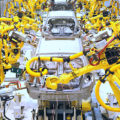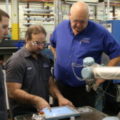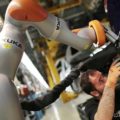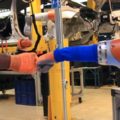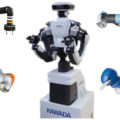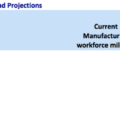 Engineer using laptop computer for maintenance automatic robotic hand machine tool at industrial manufacture factory Manufacturers are increasingly adopting collaborative robots to work alongside humans to increase efficiency: 13% of manufacturing companies currently have collaborative systems in operation, and another 15% said they plan to have these collaborative robots at work within the next year, according to a report from ABI Research, released Thursday. Manufacturing firms with more than 250 employees were the most likely to have these systems in operation already, or to have plans to implement them in the next year, the report found. These numbers are significant given that commercial class collaborative robotic systems only became readily available in 2014, the report noted. “Although industrial robots have found much success supporting manufacturing operations, the usefulness of these same systems has been limited by their high costs, complex programming, inflexibility, and inability to work in close association with humans,” Dan Kara, research director of robotics at ABI Research, said in a press release. “As a result, the market for collaborative robots, human-scale systems that are easy to set up and program, are capable of being used by workers with a wide range of qualification levels, can support multiple types of automation, and can work safely in close proximity to human workers, is very active at this time.” The rapid growth of collaborative robots is due in part to large, established suppliers as well as new, smaller companies introducing collaborative robotics technologies into the market, ABI Research noted. These companies include Universal Robots (Teradyne), KUKA, Rethink Robotics, ABB, Kawada Industries, Fanuc, Franka, Denso, and Comau. Michigan, Ohio, and Indiana are the US states currently using the highest number of industrial robots, driven by the auto industry and other manufacturing-heavy verticals, according to a recent Brookings Institution report. Demand for robots in warehouses and logistics processes is set to majorly impact supply chain operations, according to a report from Tractica: In 2016, there were an estimated 40,000 robotic units shipped worldwide—but by 2021, there will be 620,000. Know exactly where your problem areas are with SolarWinds® Virtualization Manager. Get a quick performance pulse from VM to storage, highlighting bottlenecks & resource contention along the way. Try Virtualization Manager for free >> But fear not for your job just yet: Many experts predict that robots will continue to complement human workers, and free them up to do higher-level tasks, rather than completely replace them. However, a recent report from Ball State University predicted that half of low-skilled US jobs were at risk of being replaced by automation in the future. The 3 big takeaways for TechRepublic readers 1. Some 13% of manufacturing companies currently have collaborative robotics systems in operation, and another 15% said they plan to have these collaborative robots at work within the next year, according to a report from ABI Research 2. These numbers are significant given that commercial class collaborative robotic systems only became readily available in 2014. 3. It’s likely that robots will continue to complement human workers and free them up for higher-level tasks; however, they will potentially replace certain low skill workers. |
|
| Date: | 08/31/207 |
| Author: | Alison DeNisco |
| Site: | www.techrepublic.com |
| Link to Article: | Manufacturers rapidly rolling out ‘collaborative’ robots, but half of low-skilled US jobs still at risk |
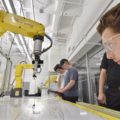 https://cobotsguide.com/wp-content/uploads/2017/09/CobotAcademy.jpg
417
742
cobotsguide
https://cobotsguide.com/wp-content/uploads/2016/06/CG-title2.png
cobotsguide2017-09-18 22:32:232017-09-18 22:32:23Barrier-free, ‘collaborative’ robots
https://cobotsguide.com/wp-content/uploads/2017/09/CobotAcademy.jpg
417
742
cobotsguide
https://cobotsguide.com/wp-content/uploads/2016/06/CG-title2.png
cobotsguide2017-09-18 22:32:232017-09-18 22:32:23Barrier-free, ‘collaborative’ robots









